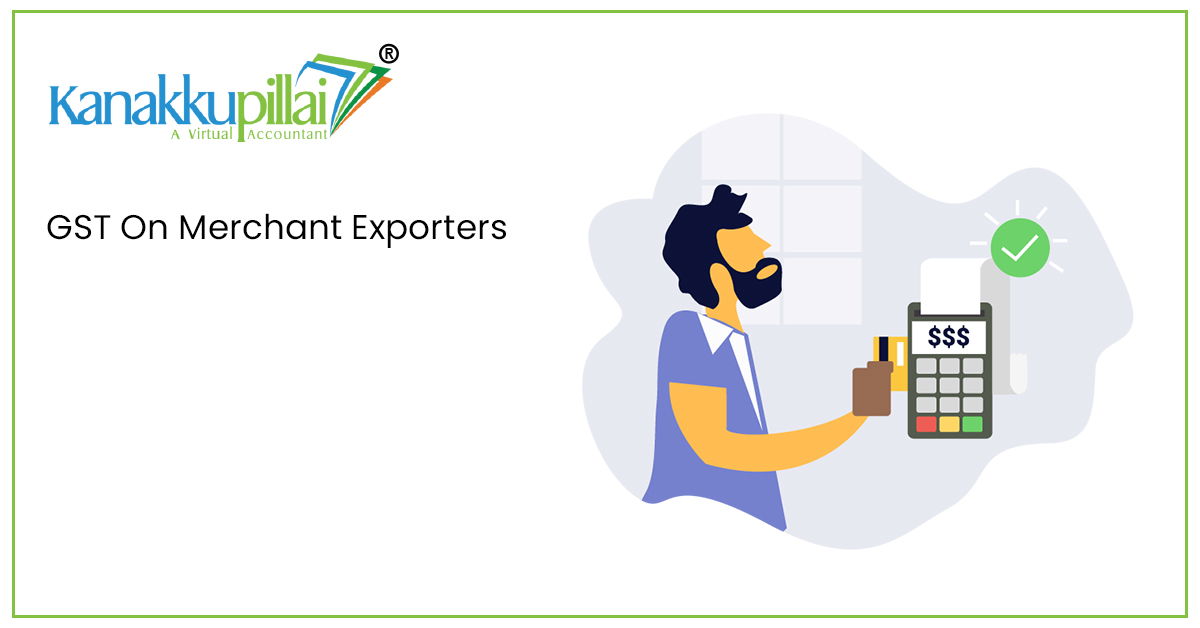Merchant Export is an activity by a trader who is exporting or is having an intention to export goods. And such trader who is engaged in the exporting activity is known as Merchant Exporters. Here the export is major of goods and not services. Mostly the exporter would not be having a manufacturing unit, and would be buying goods from the manufacturer and would ship the same to foreign customers or the customers who are located outside India.
Merchant Exports under GST – Allied Provisions
Under the Goods and Services Tax( GST), supply means “a supply of goods or services or both which is levied to tax as per provisions of Section 2(108) of the CGST Act.”
And as per section 7(5), of the IGST Act, it has been stated that “where a supplier is located in India, and the place of supply is outside India, it is treated as an inter-state supply.”
Reading both the above-stated provisions together, we can say that as the merchant exporter is located in India is exporting the goods to customers outside India, this can be treated as inter-state supply. Hence, we can say that the merchant exporter should mandatorily take registration under the GST Act.
The following points should be noted with respect to the merchant exporter under GST:
i) The merchant who is the exporter here should have registered themselves with the GST and also the Export Promotion Council or the Commodity Board recognized by the Department of Commerce of India.
ii) The merchant exporter should present the copy of the order placed with the manufacturer to the jurisdictional tax officer of the manufacturer.
iii) The concessional rate of 0.1% IGST or CGST 0.05% + SGST 0.05% shall apply when the registered supplier is supplying goods to a merchant exporter.
iv) Goods purchased by the merchant exporter from the manufacturer should be dispatched directly from the place of the manufacturer to a port, Airport, or Inland Container Depot (ICD) from where goods will be exported.
v) The goods should be exported within 90 days from the date of issue of the tax invoice by the merchant exporter.
vi) The merchant who is the exporter should specify the GSTIN of the distributor and the invoice number of the tax invoice issued by the manufacturer in the shipping bill or bill of export, as it is applicable.
vii) Once the export has been done with, a copy of the shipping bill or bill of export containing details of the manufacturer’s GSTIN & his tax invoice along with the proof of filing of the Export General Manifest (EGM) or an Export Report shall be provided by the merchant exporter.
Conditions for Availing Concessional Rate
As stipulated before, the government has provided special relief to the merchant exporters. And this is fixed to be 0.1% for any purchase of goods from domestic suppliers. But to avail of this, the following conditions should be satisfied:
- The merchant exporter should send the goods to be exported under LUT/bond but not necessarily with the payment of GST or IGST.
- The tax invoice should clearly state the GST rate of 0.1% which is being charged for the procured goods.
iii. The goods which are procured by paying such concessional rate should be exported within 90 days of the issue of a tax invoice.
- The GSTIN and the tax invoice number of the supplier or the manufacturer of the goods should be mentioned on the shipping bill.
- The merchant exporters who want to avail the benefit of the concessional rate should be registered with an Export Promotion Council or Commodity Board.
- A copy of the order, which has been placed at a concessional rate, shall be provided to the jurisdictional tax officer of the registered supplier or the manufacturer of the goods.
vii. Such goods shall be moved directly to the place and from this place they shall be transferred to the port or ICD or Airport. This condition should be complied with even in case if the goods are purchased from multiple registered suppliers or manufacturers.
viii. On export of goods, a copy of the shipping bill or bill of export along with the proof of EGM and Export Report shall be filed with the registered supplier or manufacturer as well as its jurisdictional tax officer.
Features of Export by Merchant Exporter
- When a merchant exporter is exporting the goods, it is a Zero- Rated Supply.
- A merchant exporter can export the goods under LUT/Bond and not payment of IGST.
Bill to Ship to Transaction – Merchant Export
A merchant exporter can place an order with the manufacturer to deliver the goods ordered directly to the customer or customers who are located outside India.
Say Mr. A, who is a merchant manufacturer, places an order with Mr. B, who is the manufacturer, to ship certain goods to Mr. C, who is a customer residing outside India. Now, Mr. B will issue a Bill to Mr. A and ship the goods to Mr. C.
Mr. A will have to file a shipping bill and generate an export invoice. This shall be made under LUT, and a refund of 0.1 % GST, which was charged by Mr. B, the manufacturer, shall also be claimed.
Refund Process when the Merchant Exporter is Involved
– When a merchant exporter exports goods without payment of tax and has procured goods after paying a concessional rate of GST at the rate of 0.1%, then the merchant exporter can claim a refund of the unutilized ITC at the end of a period of taxation in case of a supply of zero-rated goods or goods involving an inverted tax structure.
– Where a supplier, from whom the merchant supplier has acquired goods, procures goods from another distributor and claims a refund under an inverted duty structure, which is nothing but where such distributor has paid full GST registration to the other or the second distributor but charges concessional rate from merchant exporter, then the second distributor can claim a refund of ITC.
– In case the supplier charges the merchant exporter at regular rates of GST and the exports are done with the payment of IGST, the ITC can be used for payment of taxes or even a refund can be claimed if there is no output tax liability to be met with.
Thus, we can conclude that exports are important for any country as they would bring in foreign currency to the economy and strengthen the same. And for increasing this government always provides various benefits and concessions to such exporters.

Conclusion
Merchant exporters are a crucial link in the export chain, and the GST on their transactions can have a significant impact on their profitability. However, the Government of India has made certain provisions to ease the GST burden on merchant exporters, such as the introduction of the LUT (Letter of Undertaking) and the refund mechanism.
As a merchant exporter, it is crucial to understand the GST regulations and ensure compliance with them. Non-compliance can result in penalties and legal consequences, which can harm the company’s reputation and financial standing. Therefore, companies should consider seeking the assistance of professionals such as Kanakkupillai to navigate the complexities of GST and ensure compliance. By doing so, merchant exporters can take advantage of the benefits that GST offers while minimizing the compliance burden on their businesses.





